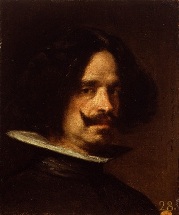Diego de Silva y Velazquez
Biography

The Spanish painter, Diego de Silva y Velázquez, considered to be the most outstanding artistic celebrity of his time, was born in Seville in 1599. His mother was from Seville and his father was of Portuguese descent. Starting his career while still very young, Velazquez was greatly influenced, not only pictorially but also culturally and in literary themes by Francisco Pacheco, a painter in the mannerist style. At the age of 18 he launched out on his own after passing the painters' guild examination in his home town.
During his first stage, from 1618 to 1623, Velazquez painted some religious works and genre scenes in which he developed the chiaroscuro technique and which transmit the significant influence of Caravaggio's naturalism. His capacity for turning religious scenes into something intimate and realist is an important trait that he passed on to other artists of his time.
In 1623 he was appointed painter to the court and thus began a career in the royal household where he received several titles, among them Gentleman Usher and Knight of the Order of St. James. During this time he painted numerous portraits of the royal family, achieving great realism and sobriety in his handling of light.
During his two trips to Italy, one in 1629 and the other in 1648, Velazquez underwent a transformation in his painting style, imbuing his work with new light and brighter colors and achieving aerial perspective.
It is in the final stage of his work that he accomplished the greatest style development and painted his masterpieces. He died in Madrid in August 1660 after a long illness.
Works
Velazquez kept the somberness and the realism but was never a big enthusiast of mythological figures or of drawing human contours. What was important to the painter was not to amaze by his capacity to reproduce what he saw, but to demonstrate how far he could go with his painting.
Using a dazzling variety of brushstrokes and a subtle color harmony he achieved effects of form, texture, radiance and atmosphere which made of him a precedent for impressionism.
During the subsequent 18th, 19th and 20th centuries many were the artists who were inspired by the painting of Velazquez to fashion some of their most outstanding projects, in particular Francisco de Goya, Edouard Manet, Auguste Renoir, Claude Monet and Pablo Picasso.
The Meninas (The Maids of Honor)
This was painted in 1656 and has as its subject a portrayal of the infanta Margarita, the daughter of Philip IV, surrounded by her maids of honor and family in a room at the Alcázar in Madrid. This painting is considered to be one of the supreme works in universal painting and it was thereafter greatly imitated and admired by all. It was outstanding because in it the painter painted himself painting the painting, as if to affirm the supremacy of the art of painting. In addition the different perspectives are arranged to achieve an atmospheric impression giving rise to an extraordinarily complex spatial effect.
The Surrender of Breda
This is a painting of the historical episode which took place in Breda (Holland) in 1625 when the Dutch were defeated by the Spanish regiments and the city of Breda was taken. This would eventually end in defeat for Spain and independence for the Low Countries. The work was painted in 1634 for the Salon de Reinos at the Buen Retiro Palace. Velazquez achieved impressive realism in the painting and, rejecting conventionalities, he treated the subject of war with great sensitivity, placing the emphasis on the concepts of clemency and compassion for the defeated.
The Drunkards
This work was painted for Philip IV en 1629. The mythological nature and the amusing tone of the painting is conveyed by representing Bacchus as the god who gives man the gift of wine in order to somehow free him from life's everyday troubles. By mingling a tavern scene with the god of wine
Velazquez managed to introduce an irreverent aspect into a mythological subject.
